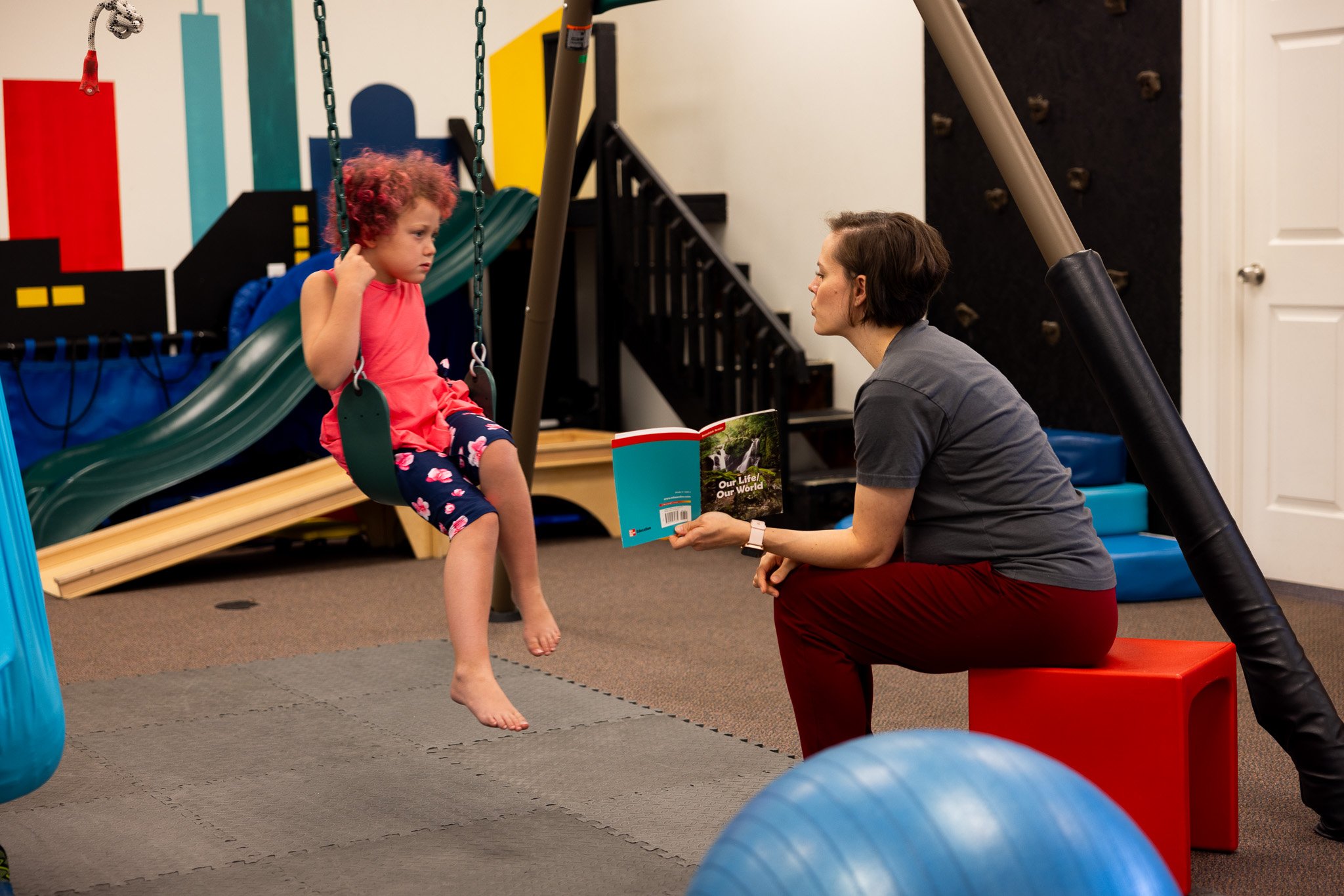
Emotion & Body Coding: A Clinical yet Spirit, Body, Mind Pathway to Healing for Kids and Adults
In today’s fast-paced world, more families are seeking effective ways to support emotional wellness, reduce stress, and reconnect with a sense of inner balance. One method bridging the gap between clinical understanding and spiritual healing is Emotion Code® and Body Code®, created by holistic physician and chiropractor Dr. Bradley Nelson.
This system is transforming the way children and adults release stored emotional energy, improve emotional regulation, and support whole-body wellness, and can help achieve goals.

Why Parent Participation & Follow-Through Are the Keys to Success in Pediatric OT, PT, and Speech Therapy
When a child receives occupational, physical, or speech therapy, the goal is always the same: to help them build the skills they need to thrive in everyday life. Therapists play an essential role in assessment, treatment planning, and skill-building—but the progress a child makes during weekly sessions is only one piece of the puzzle. The biggest gains often happen between appointments, and that’s where parents and caregivers make all the difference.
Below is a look at why parent involvement matters so much, what it really looks like day-to-day, and how you can support your child’s therapy journey for the best possible outcomes.

Boredom For The Brain
Boredom fuels creativity and imagination. When the brain isn’t being fed constant stimulation, it naturally starts wandering inward. This “default mode network” (the brain’s daydreaming system) begins making loose, playful, unexpected connections—exactly the kind that fuel creativity. Children often generate their most imaginative play after they’ve moved through that uncomfortable “I’m bored” stage. It strengthens problem-solving skills. Boredom creates a kind of mental “itch” to do something meaningful or engaging. That discomfort nudges the brain to invent new ideas, seek new solutions, or explore new activities. It’s essentially a catalyst that pushes us to figure things out ourselves.

Pre-Linguistic Skills: How to Teach Your Baby to Point, Wave, and Imitate Sounds
Learning to talk begins with several different foundational steps that you as parents can work on at home to support your child’s communication abilities.

Echolalia in Autism: Is My Child Just Repeating Phrases, and How Can We Build Spontaneous Language?
Some children frequently communicate by repeating lines from their favorite television shows, or directly imitating what others say to them. This form of communication is called echolalia. Echolalia refers to repeating words, phrases, or sentences spoken by others. It can occur immediately (right after hearing something) or be delayed (repeating something heard earlier — even hours, days, or weeks later).

Understanding Primitive Reflex Integration
Primitive reflexes originate in the brainstem and are present before birth. They help newborns adjust to life outside the womb by supporting early movement, sensory development, and neural growth.

What is Childhood Apraxia of Speech? The 5 Signs That Signal a Motor Speech Disorder, Not a Simple Delay
Every child learns to produce speech sounds and talk at their own pace. Some children pick up new words almost overnight, while others take a little more time to find their rhythm. It’s normal for early speech to sound a bit “off” at first—like “buh” for “ball” or “poon” for “spoon.” Most of these sound differences are just part of typical development and fade as kids gain more control over their mouth movements and as they age.

Understanding Prelinguistic Skills: The Building Blocks of Communication
Before babies say their first words, they’re already busy learning how to communicate. These early skills — called prelinguistic skills — form the foundation for language development. By understanding and supporting these skills, caregivers can help children build strong communication abilities that will support them for life.

Articulation vs. Phonological Disorder – Why Your Child Says “Wabbit” for “Rabbit”
As children are growing and developing, it is common for development of some sounds to come quickly and for it to take more time to master other sounds—speech development is a gradual process! Many little ones go through a stage where their “baby talk” sounds adorable, like saying “tat” for “cat” or “wabbit” for “rabbit”. These errors can be part of early typical development as kids are learning how to coordinate their lips, tongue, and breath for clear speech. Sometimes it’s a simple developmental pattern that will fade with time, while in other cases, it may be a sign of an articulation or phonological disorder. If certain sound substitutions persist beyond the expected age range or make your child’s speech difficult to understand, it might be time to check in with a speech-language pathologist (SLP). SLPs have the background training and knowledge to help identify the reason for these errors in sound production. Understanding the difference between these two disorders can help you know when to seek extra support.

Education, Sensory Processing, & Children In Motion: A Deep Dive With OT Rhonda Roth
The world of occupational therapy (OT) is vast and dynamic, but at its heart lies a singular goal: empowering individuals to live life to the fullest. On a recent episode of the Therapy Unmasked podcast, we sat down with the incredible Rhonda Roth, an occupational therapist and educator whose career perfectly embodies this principle.
Rhonda's story is a compelling journey through diverse clinical settings—from acute care and skilled nursing to schools—before she found her true calling in pediatric Sensory Integration. The conversation wasn't just a look back; it was a powerful masterclass in clinical philosophy and the future of the OT profession.

Stop Chewing on Shirts! Understanding and Addressing Oral Sensory Needs in Kids
If your child constantly chews on their shirt collars, sleeves, pencils, or even toys, you’re not alone! Many parents worry about this habit—wondering if it’s behavioral, anxiety-related, or just a phase. In pediatric occupational therapy, we often see children who chew as a way to meet an oral sensory need—their body’s way of seeking calming or organizing input through the mouth.

Is Your Child Getting the Best Speech Therapy Possible? Understanding the Private Practice Advantage
"Does your child need speech therapy? It's wonderful that public schools offer it, but is your child getting the attention they truly need?
At Ability Innovations, we offer what school settings often can't: One-on-one, consistent therapy built around your child. We don't believe in group sessions or once-a-month meetings.
Forget the boring worksheets and flashcards! We use the power of Play-Based Learning. We've created a vibrant environment where kids learn best—through fun and meaningful activities—so they can reach their full potential faster.
And unlike the school setting, you won't be left in the dark. We make Parent Involvement easy! You'll have direct access to your therapist every week to discuss goals, ask questions, and learn how to reinforce progress at home.
If you're ready for more dedicated attention, more consistency, and better results for your child’s speech, it’s time to reach out.
Contact Ability Innovations today for an evaluation and start your child on the path to confident communication!"

Are You Worried About Dysgraphia?
Dysgraphia is a neurological condition that affects a child’s ability to write legibly and make it readable. It basically impacts handwriting, spelling, and organizing thoughts on paper, often making writing tasks more challenging than their peers, despite normal intelligence and adequate instruction. Common signs include illegible handwriting, inconsistent letter formation, floating letters, spacing issues, difficulty with grammar and punctuation, and/or slow writing speed. It may also involve trouble with fine motor skills needed for writing, like the grasp on a pencil, small movements of the hand while writing, and eye-hand coordination.

Is Picky Eating A Problem?
Picky eating can be a normal part of childhood, but it becomes a problem when it leads to nutritional deficiencies, developmental delays, or emotional distress. If a child consistently avoids essential food groups, there is a risk of not receiving adequate vitamins, minerals, and other nutrients necessary for growth and overall well-being. In more severe cases, picky eating can lead to conditions like malnutrition or failure to thrive. Long-term avoidance of certain foods can result in gastrointestinal issues, fatigue, and weakened immunity. Picky eating can also be linked to psychological conditions such as anxiety, OCD, or eating disorders like ARFID. If picky eating is causing significant distress or impacting overall health, it's essential to seek professional help. Signs that it might be time to seek help include noticeable weight loss, chronic fatigue, growth delays, or frequent gastrointestinal problems. Emotional signs such as anxiety around meals, extreme fussiness, or feeling overwhelmed by the prospect of trying new foods are also important to note.

Unlocking Convenience: The Perks of Using Our Client Portal
In today’s fast-paced world, managing your health care shouldn’t be a hassle. That’s why we’re excited to highlight the benefits of using our client portal, designed to make your experience as seamless as possible. Once you log into the portal, you can access everything you will need from the home page. Here are some key features that you’ll love:
# 1. Easy Access to Appointment Details
No more flipping through papers or searching through emails! With our client portal, you can quickly check the date and time of all your upcoming appointments. This feature ensures you stay organized and never miss a visit.
# 2. Simplified Invoice Management
Keeping track of unpaid invoices is now a breeze. Our portal allows you to view any outstanding invoices and pay them directly through the platform. It’s secure, efficient, and saves you time—no more waiting for paper bills to arrive!
# 3. Streamlined Registration Process
Need to fill out registration documents? You can do that right in the portal! This feature allows you to complete necessary forms online, making your visits quicker and more efficient.
# 4. Direct Communication with Our Team
Have a question or need clarification? The client portal offers a convenient way to communicate directly with our clinic and providers. Whether it’s a quick question or a more detailed inquiry, you can connect with us easily, ensuring you get the support you need.
By utilizing our client portal, you gain greater control over your health care experience. We encourage you to take advantage of these features to enhance your interaction with our clinic. Sign in today and discover how easy managing your health care can be!

The Power of Two: How Co-Treatments Can Transform Your Child's Therapy
At Ability Innovations, our goal is to be interdisciplinary. We believe that by working together, we can provide better care and achieve greater success for the children we work with. According to Nick and Megan, co-treating offers several key benefits:
Better Outcomes: When two therapists from different specialties work together, a child often makes greater progress in both areas. The therapists can build on each other's work and augment the benefits of each session. For example, an OT might work on a child's core strength on a swing, while the SLP uses that regulated state to encourage communication and language skills.
Efficiency for Parents: Co-treating can significantly shorten the time a family has to spend at the clinic. Instead of attending two separate appointments, you can get two therapies in one session. This is a huge time-saver for busy families.
Holistic Care: Therapy isn't just about one specific skill; it's about helping a child function better in the world. By combining two disciplines, therapists can address multiple goals at once. Megan shared a great example of a scavenger hunt she did with an OT. While the child was working on fine motor skills and handwriting with the OT, Megan had them practice and write words that targeted their speech sounds.

Sensory Avoidance Vs. Sensory Seeking
In the world of occupational therapy, sensory processing plays a vital role in helping individuals navigate their daily lives. Two common sensory patterns—sensory avoidance and sensory seeking—represent opposite ends of the sensory spectrum. Sensory avoidance refers to individuals who are overwhelmed or distressed by certain sensory input, such as bright lights, loud noises, or specific textures. These individuals often withdraw from stimuli, preferring quiet, calm environments. In contrast, sensory seekers actively crave sensory input and may engage in behaviors like touching everything around them, making loud noises, or constantly moving.

Why Consistent Toe Walking Shouldn’t Be Ignored
Toe walking is exactly what it sounds like: a walking pattern where a child walks on the balls of their feet without letting their heels touch the ground. It can be habitual, neurological, or linked to developmental or sensory issues.
While it may look harmless, consistent toe walking can lead to several physical and developmental issues if not properly addressed.

Is Your Child Struggling? Here’s What to Know About Pediatric Speech Therapy
If you've ever wondered about the signs of a language delay in a child or the benefits of speech therapy, the video "What Is Pediatric Speech Therapy?" by Ability Innovations provides a helpful overview. The video focuses on pediatric speech therapy for children from birth to 21 years old and highlights a play-based approach to treatment.

Bedtime Strategies To Help My Child Wind Down
If you're a parent of a child who receives pediatric occupational therapy, chances are you've seen how sensory needs, emotional regulation challenges, or developmental differences can affect your child’s sleep. Bedtime can become a battleground—or a never-ending routine of delays, restlessness, and midnight wake-ups. The good news? There are strategies that can help. Occupational therapy often addresses not only daytime functioning but also nighttime routines, because sleep is foundational to your child's development, behavior, and overall well-being.
Here are some OT strategies you can try to help your child wind down and stay asleep:

